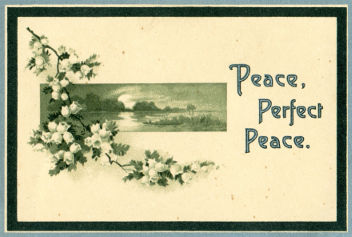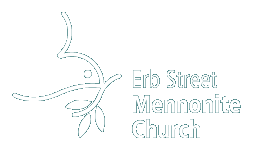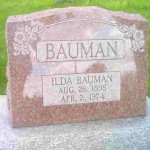Cemetery
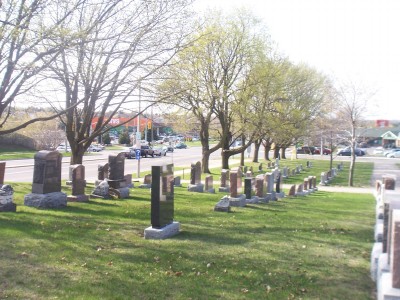 Erb Street Church Cemetery
Erb Street Church Cemetery
407 Erb Street West Waterloo
South-East corner of Erb Street and Fischer-Hallman Road
The 1851 deed for two roods of land (one half acre) sold to the church for seven pounds ten shillings by David and Elizabeth Eby stated that the land was to be used for a “meeting house and burying ground.” In 1880, David and Elizabeth’s son David B. and his wife Lydia (Bowman) Eby sold an additional acre adjoining the original property for one hundred dollars.
After the new church was built closer to town in 1902, the cemetery remained. It was on the usual route that church members used to drive into town and so they often passed by. Now surrounded by the city which expanded especially in the 1970s and 1980s, the cemetery is an oasis in the midst of noisy traffic and busy malls. That small parcel of land is all that remains to suggest something of the pastoral crossroads of 1851, a time when the setting thereabouts was acre upon acre of cultivated fields, a few farm buildings, woodlots, and a new brick meetinghouse.
Who is buried in the cemetery?
Some of the early David Eby members were buried at First Mennonite Church, 800 King Street East, Kitchener and Martin’s Meetinghouse, King Street North and Bridge Streets, Waterloo.
The Erb Street Mennonite Church Anniversary Cemetery Walk from 2001 can be downloaded and printed in either booklet or non-booklet form and you can guide yourself around a few highlights of the cemetery. The signposts are no longer mounted, but the included map will guide you.
The Waterloo Branch of the Ontario Genealogical Society in 1989 did a transcription onto CD of the cemetery stones.
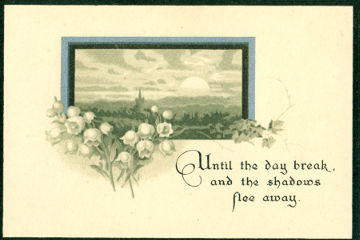
Funeral Card Cover (1929)
What are their stories?
The profiles following were taken from Erb Street’s Cemetery Walk, published in 2001, with some updates.
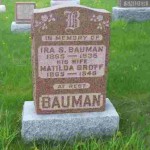 Ira S Bauman 1865 – 1935
Ira S Bauman 1865 – 1935
Matilda Groff Bauman 1865 – 1949
The family moved from their farm to 128 Erb Street West, across from the church, in 1911 when the street wasn’t yet paved. Ira and Matilda’s daughters had attended the David Eby Sunday school, Sunday night Young People’s meetings and Singing Schools. Matilda was a charter member of the Charity Circle.Ira headed a committee responsible for placing 1,340 German/Russian Mennonite immigrants who came to Waterloo in 1924. Six hundred were expected in the first group on July 19, but over 800 arrived. Homes were found for everyone. The girls remember many meetings at their home and all the time their father spent on the phone trying to find accommodations.
Erb Street News September 1976
A Brief History of the David Eby Church by Greta and Albert Hunsberger
Ilda Bauman, as Joseph Cramer’s co-worker, pioneered the work of the House of Friendship in Kitchener.” She developed an interest in Jewish evangelism and was one of a group of women who cooked soup and collected clothing to help immigrants, some of them Jews. Besides cooking at the new House of Friendship, she and Mr. Cramer made numerous home and hospital visits, later speaking at churches, to women’s groups and at services at the “mission.” “Ilda had been the real manager of the place, and had been there since the very beginning” but after Mr. Cramer died, “it seems not to have occurred to the committee that she might be considered” as the new director. An advisory Committee “released” her. After her ten years at the House of Friendship, “she never again found a sphere of service in which to immerse her time and energies.”
Willing Service: Stories of Ontario Mennonite Women by Lorraine Roth, pg 105
A Mighty Flood of Justice: The Story of House of Friendship by Ferne Burkhardt
Jacob B Erb 1808 – 1893
Mary Clemens Erb 1814 – 1893
Jacob and Mary were another in the cluster of pioneer families which settled in the David Eby meetinghouse area and one of the founding families of the congregation. The farm on lot 31 of the German Company Tract (GCT) remained in the Erb family for about 130 years until it was sold in 1974. Although the house was originally slated to be demolished in the 1980s, it was saved and beautifully restored to be part of the surrounding subdivision. Jacob and Mary’s descendants continue to attend Erb Street.
Kitchener-Waterloo Record, November 2, 1985, “180 years of history lost to progress”
correspondence from a family member
Path of a People by Karl Kessler, pg 13
 Mary Ann Eby Cressman 1870 – 1941
Mary Ann Eby Cressman 1870 – 1941
Allen Cressman 1866 – 1941
Mary Ann, daughter of David B Eby and Lydia (Bowman) Eby, was one of the last of pioneer David G. Eby’s direct descendants to attend Erb Street. The rest scattered. She was also the last of the clan, the third generation (David G, David B, Mary Ann) to live at the old farmstead at Fisher-Hallman Road and Erb Street West. Allen was caretaker of the David Eby meetinghouse and grounds in the 1890s.
Path of a People
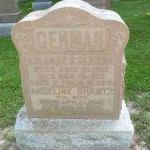 Solomon B Gehman 1841 – 1912
Solomon B Gehman 1841 – 1912
Angeline Shantz Gehman 1846 – 1928
Controversial, charismatic, Gehman was a prominent preacher of the revivalist period at the Detweiler Church (Roseville, North Dumfries Township) in the latter 19th century. With Noah Stauffer, he co-led the prayer meetings in the David Eby neighbourhood in 1885 that contributed to the schism four years later. After retiring he attended Erb Street and was buried in the church cemetery. Read more about Gehman in Reg Good’s Detweiler: Detweiler’s Meetinghouse: A History of Mennonites near Roseville, Ontario.
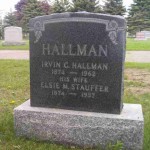 Irvin C Hallman 1874 – 1962
Irvin C Hallman 1874 – 1962
Elsie M Stauffer Hallman 1874 – 1937
Irvin bought the David Eby farm around 1903 and the Hallmans sold it about 1980 when it comprised what is Zehrs Beechwood plaza in 2008. The original David Eby farm, part of log 32 GCT, covered all four corners at Erb West and Fisher-Hallman Road.
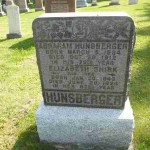 Abraham J Hunsberger 1834 – 1912
Abraham J Hunsberger 1834 – 1912
Elizabeth Shirk Hunsberger 1843 – 1924
Abraham was deacon at David Eby’s/Waterloo Mennonite from 1892 – 1908, ordained to fill the void left by Deacon Menno S. Shantz, who left with Elias Snider (his father-in-law) to go with the Old Order in the 1889 schism. In 2007, Erb Street members continue to include descendants of Abraham and Elizabeth. Note: for some years, Erb Street Mennonite Church was referred to as the Waterloo Mennonite Church.
A Brief History of the David Eby Church
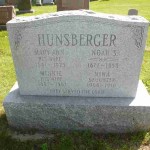 Noah Sherk Hunsberger 1877 – 1958
Noah Sherk Hunsberger 1877 – 1958
Mary Ann Shantz Hunsberger 1881 – 1925
Minnie Witmer Hunsberger 1887 – 1987
Noah was pastor of David Eby/Waterloo Mennonite/Erb Street Church from 1900 – 1920 and from 1923 – 1929 when J B Martin was called. He had been ordained to preach in the English language at a time when the change from German to English was underway in the Mennonite Conference of Ontario. After Erb Street, Noah then pastored at various churches including the Baden Mission. By vocation he had a woodworking shop for some years and also was a beekeeper.
Path of a People
Steiner, Sam. “Hunsberger, Noah S..” Global Anabaptist Mennonite Encyclopedia Online. July 2001
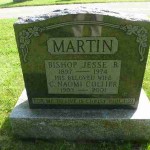 Jesse B “J B” Martin 1897 – 1974
Jesse B “J B” Martin 1897 – 1974
Naomi Collier Martin 1903 – 2001
Jesse was born into the Old Order community; ordained by the Mennonite Conference in September 1925 for the Weber Church, Strasburg [Kitchener]. In 1926 he and Naomi were married. She left a teaching job in Missouri. J B, as he was known, assumed the pastorate of Erb Street in 1929 – living in the first Mennonite parsonage in Ontario, three blocks from the church – and in 1947 was ordained as bishop. He worked part-time in a dairy, and for 34 years taught at Ontario Mennonite Bible School (later the Bible Institute), being principal from 1957 – 1966.Naomi grew vegetables, canned them and fruits and jams. She reworked second-hand clothes for her children, took in boarders and did housecleaning for other families.During the Second World War, in November 1940, J B was one of a delegation of eight Mennonite leaders which sat down for discussion with senior officials of the Department of National Defence to negotiate with the federal government for alternate service for Mennonite young men. J B spent many months away from home, negotiating with government officials and visiting the young men in camps. In his absence, Naomi carried on – at home and at church. She had to respond to the cares and concerns which would have come to J B.In 1953 Naomi and J B spent six months visiting mission personnel in Belgium and France and helped set up a mission program in Jerusalem. J B semi-retired in 1964, preaching at various locations until 1972. After J B’s death, Naomi volunteered at Fairview Mennonite Home helping residents.
A Brief History of the David Eby Church
Willing Service, pg 137
Waterloo County: An Illustrated History
Waterloo Public Library
J B Martin’s personal records are in the archives at Conrad Grebel University College
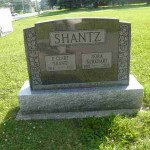 E Clare Shantz 1914 – 1995
E Clare Shantz 1914 – 1995
Nora Burkhart Shantz 1915 – 2006
Clare was born on a farm where now are the Eastwood Collegiate and Sunnyside Home. With his parents – Titus and Mary Ann (Detweller) Shantz – he attended First Mennonite then Stirling Avenue churches and was fully involved in each as Sunday school teacher, song leader, in male quartets, the Literary Society, Young People’s Bible meetings, etc. In the early 1940s, Clare attended Ontario Mennonite Bible School. Nora was cook there, making meals for an average of 125 – 150 students: three meals a day, seven days a week. They were married in July 1945 and in September that year Clare joined Nora as a member of Erb Street. He was chosen by lot and ordained as deacon in 1948, serving until 1980, then was deacon emeritus until his death.In the 1950s Clare fell from a ladder, while working as a carpenter for J C Hallman, and severed his spinal column. After months of adjustment and rehabilitation, he continued as service manager at J C Hallman’s until retirement. Some of Clare’s many achievements – despite being restricted to a wheelchair – were getting a ramp built at Erb Street Church, and building trailers designed for his special needs so that he and Nora could travel.Nora’s birthplace was on the farm situated on the north west corner of Columbia and Philip Streets in Waterloo. Her parents were Menno and Hattie (Lichty) Burkhart and the family attended Erb Street Mennonite Church from about 1922. There was a time at Erb Street when Sunday school pupils could choose their teacher: Nora moved with one class of teenage girls for nine years. The Sunshine Band Committee (later Girls’ Club), Junior Charity Circle, the Beacon’s WMSA (later WMSC Circle) and librarian were other leadership roles Nora took.In 1958, 1959 and 1960 Nora underwent many operations and treatment for cancer: one operation removed one eye and half of her upper jaw. She was told she would probably not live for another year.
Erb Street News September 1977
A Brief History of the David Eby Church
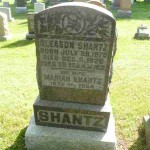 Mariah Shantz Shantz Snyder 1872 – 1964
Mariah Shantz Shantz Snyder 1872 – 1964
Cleason Shantz 1870 – 1920
The Shantz farm is shown on the Bird’s Eye View map c1891 of the Town of Waterloo. It was located where Globe Furniture and Canada Barrels and Kegs/Canbar once stood – the now-empty space (in 2008) between Silver Lake and Father David Bauer Drive.People visiting each other between Wilmot and Woolwich townships would take a break in their travels and stop at the Shantz home to water, feed and rest their horses.Mariah attended the David Eby and Erb Street Churches and from the beginning of the Charity Circle was very active, serving as president and vice-president. She hosted many Charity Circle meetings in her home, especially in the winter because they always had coal and the rooms were warm! (Cleason was a teamster and had coal.) Mariah knitted socks, mitts and sweaters for conscientious objectors in the work camps, for Mennonite Central Committee workers and relief programs From her large garden she gave produce to the orphanage and to needy families. In 1927 Mariah married Abram Snyder 1866-1938. He is also buried in the Erb Street cemetery.Cleason was very involved and active on boards and committees at Erb Street. He was a member of the Building Committee for the present structure, built in 1902.
Willing Service
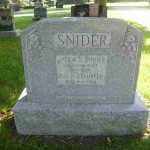 Ida B Stauffer Snider 1868 – 1966
Ida B Stauffer Snider 1868 – 1966
Jacob S Snider 1861 – 1947
Ida, who lived 98 years, is the daughter of Noah K Stauffer and Barbara Betzner.Ida was the first president of the Waterloo Mennonite Women’s Charity Circle in 1908. It was formed to sew clothes for needy “Fresh Air” city children hosted for a week or two in the summer by rural or farm families. From 1908 to 1939 Ida served terms as vice-president, on the buying committee, president again, and on the quilt-patch cutting committee. From 1918 to 1929 she served on the executive of the newly formed Ontario Sewing Circle. The work of the Charity Circle was always an important part of her life.
Willing Service, pg 13
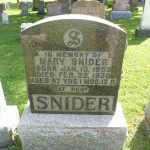
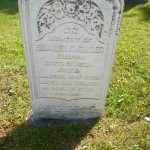 Mary Snider 1863 – 1930
Mary Snider 1863 – 1930
Samuel S Snider Sr 1821 – 1912
Anna C Snider 1824 – 1890
Mary’s father Samuel donated land on Erb Street for $1 for the new 1902 church. Her parents’ graves are in the same row as hers. Mary lived on the Snider farm until the mid 1890s. It was just west of Waterloo where the Westmount Golf Club is located. In 1896 she was appointed matron of the Berlin (now Kitchener) Orphanage on the corner of King and Victoria Streets, resigning about 1927. In 1904 a baby boy was left on the steps of the orphanage and Mary looked after him, named him Edward and eventually adopted him.
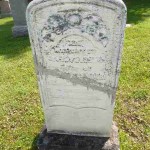 Mary was an active member of Berlin Mennonite Church (now First Mennonite) and in 1908 was involved in organizing Sisters’ Aid (later called Ladies’ Aid) and served on the executive. In the 1920s Mary “was somewhat vocal” during the dispute when the conference pressured the congregation to discipline women who were wearing hats instead of the prescribed bonnet. “…she complained that an unfair distinction was being made between men and women in legislating dress regulations.” When the women came under church discipline, Mary was one of the group which withdrew and organized an independent congregation: Stirling Avenue Mennonite Church. In 1925 Stirling women organized a Women’s Missionary Society with Mary elected president. We think she was also active in the Women’s Christian Temperance Movement.
Mary was an active member of Berlin Mennonite Church (now First Mennonite) and in 1908 was involved in organizing Sisters’ Aid (later called Ladies’ Aid) and served on the executive. In the 1920s Mary “was somewhat vocal” during the dispute when the conference pressured the congregation to discipline women who were wearing hats instead of the prescribed bonnet. “…she complained that an unfair distinction was being made between men and women in legislating dress regulations.” When the women came under church discipline, Mary was one of the group which withdrew and organized an independent congregation: Stirling Avenue Mennonite Church. In 1925 Stirling women organized a Women’s Missionary Society with Mary elected president. We think she was also active in the Women’s Christian Temperance Movement.
The forerunner of the present day Mennonite Youth Fellowship (MYF) were Young People’s Bible meetings (YPBM) and before that, Edification Meetings. In the 1890s Mary was instrumental in organizing the first Edification Meetings.
When her son Edward died suddenly of peritonitis in 1930, Mary was broken-hearted. She died the day of his funeral.
Willing Service, pg 212
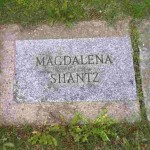
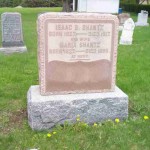 Magdalena B Latschaw Shantz 1832 – 1856
Magdalena B Latschaw Shantz 1832 – 1856
Isaac B Shantz 1827 – 1917
Maria Shantz 1827 – 1885
Magdalena’s is the earliest recorded death in the Erb Street cemetery. On October 3, 1850 she married Isaac B Shantz. They resided near Berlin where she died February 22, 1856 leaving a family of three children: Hannah, Amos and Veronica. Isaac remarried to Maria in December of 1856, and they had 7 more children
A Biographical History of Waterloo Township by Ezra Eby, #4194 and 6834
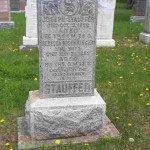 Rebecca Rosenberger Stauffer 1801 – 1882
Rebecca Rosenberger Stauffer 1801 – 1882
Joseph Stauffer 1802 – 1880
Rebecca and Joseph have the earliest recorded dates of birth in the cemetery and were one of the cluster of pioneer families which cleared the land and farmed in the David Eby meetinghouse area. Their farm was just south of the Ebys.
A Biographical History of Waterloo Township by Ezra Eby, #7390
